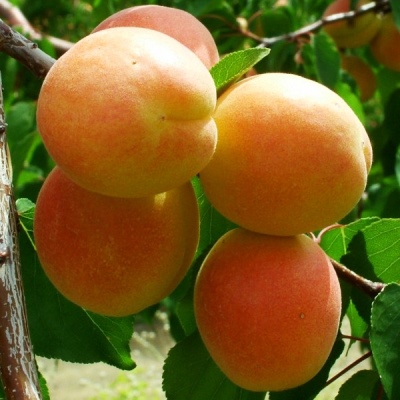
- Authors: Republic of Belarus
- Fruit weight, g: 70
- Fruit shape: rounded, slightly flattened from the sides
- Fruit color: bright orange, with small red spots on the sunny side
- Pulp color : Orange
- Pulp (consistency): very juicy, tender
- Fruit taste: sweet and sour
- Bone size: medium
- Separability of the bone from the pulp: good
- Appointment: universal
The apricot variety Pamyat Shevchuk is universal, quite popular, for many years it has attracted summer residents with its unpretentiousness. It is appreciated for its good survival rate in the Russian climate. In addition, the variety is large-fruited, with very tasty both fresh and canned apricots.
Breeding history
The variety was obtained in the Republic of Belarus. The breeding work was carried out at the Research Institute of Fruit Growing on the territory of the Pinsk stronghold.
Description of the variety
The tree is medium-sized, with a spreading spherical crown. Plants can become quite large, much depends on the rootstock, they quickly gain height. The crown is not thickened.
Fruit characteristics
Apricots are very large, weighing up to 70 g. The shape of the fruit is round, slightly flattened from the sides, quite beautiful and regular. The color of the surface is bright orange, small red spots appear on the sunny side. The stone is medium inside, well detachable. The pulp is orange, not too dense.
Taste qualities
The fruits are very tasty, with juicy tender pulp, sweet and sour.
Ripening and fruiting
Apricot Shevchuk's memory belongs to the middle in terms of ripening. Trees bear fruit in late July - early August. The first crop can be harvested 2-3 years after planting.

Yield
Up to 60 kg of fruits are harvested from the tree. During the first 5 years from the start of fruiting, the harvest will be twice as modest, about 28.5 kg.
Growing regions
In Russia, the apricot Memory of Shevchuk is grown mainly in regions with a climate similar to those in Pinsk and other cities of Belarus. He takes root well in the Voronezh, Oryol regions, as well as to the south.
Self-fertility and the need for pollinators
The variety is self-fertile. Doesn't need pollinators.
Growing and caring
The variety of Belarusian selection is quite well adapted to the Russian climate. It can be planted in a permanent place in the spring, without waiting for the start of sap flow. Caring for a young plant is as simple as possible. During the first 5 years, while there is an active climb, the trees are regularly watered, forming furrows for this. It is necessary to use warm, settled water for this.
After any moisture, including rain, the soil in the trunk circle must be loosened. Top dressing starts from 3-4 years of tree life. The tree also needs protection from the most common pests, which consists of preventive spraying and whitewashing of the trunk surface.



Disease and pest resistance
A variety with good immunity, resistant to most diseases. It is resistant to clasterosporia and stone fruit scab.

Winter hardiness and the need for shelter
Plants are characterized by increased winter hardiness.
Location and soil requirements
The choice of location is of the utmost importance to the successful cultivation of the tree. For the Pamyat Shevchuk variety, it is necessary to select areas with light soils, well-ventilated, not waterlogged. The close occurrence of groundwater, planting in lowlands is contraindicated for him. Wind protection is important. Places next to a fence or a house are suitable, but not from the south, but from the west.
Review overview
According to summer residents, the apricot variety Memory Shevchuk is well adapted for the Russian climate, but it will not work to grow it in the Moscow region, a milder climate is needed. Otherwise, there are no complaints. Trees are often grafted onto low-growing rootstocks in order to improve frost resistance and reduce the height of an adult plant. The variety is praised for its early maturity; there is no need to wait long for the first signal specimens. In addition, it can grow as a single apricot on the site.
Among other positive points in the gardeners' reviews, one can single out a very beautiful appearance of the fruits. They are painted in a solid sunny yellow tone, look attractive, and are suitable for growing for sale. The disadvantages of summer residents include the not too high resistance of the plant to damage by insect pests, and in cold years also fungal diseases.































































